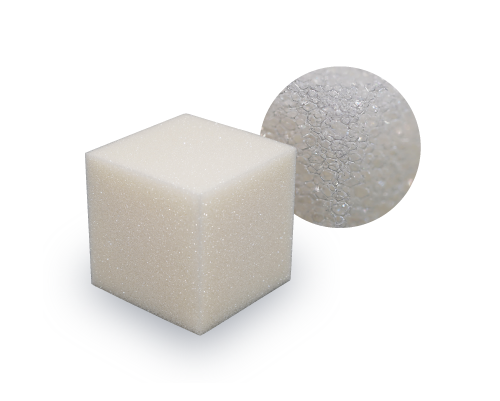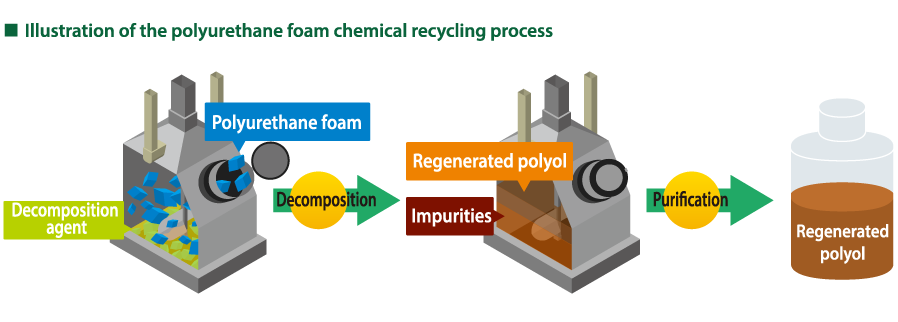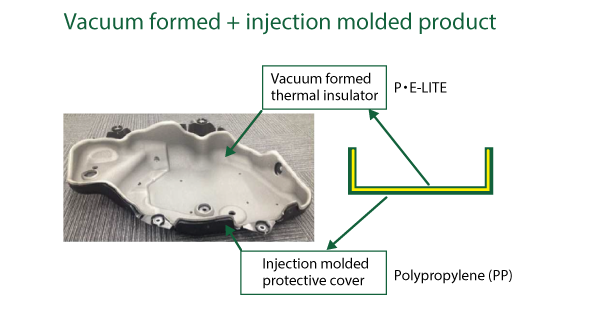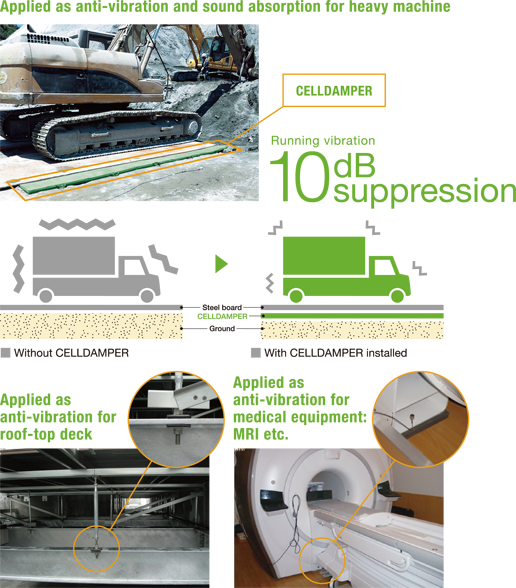Eco-friendly Products
Recycle Material

Recycling
Further advancements in eco-friendly technology
Polyurethane Foam
Chemical Recycling
Our main product at INOAC is polyurethane foam. Since it is foam material, much of its production is volume-based, and it is a resin that strongly needs to be recycled.
However, while some polyurethane foam waste is reused as materials and thermally recycled to be used as recycled materials and heat sources, some is also discarded without any efficient use. For that reason, we are working to boost its recycling rate by developing chemical recycling technologies to recycle the foam as raw materials.


Recycling
Efforts to significantly reduce waste
REPECO®
REPECO® is a pellet made by recycling cross-linked polyethylene foam (hereinafter referred to as PE Light®) cutoffs produced by INOAC.
Thanks to this recycling technology, nearly all material cutoffs can now be recycled into the original product they were produced for, PE-LITE®. We expect this to significantly reduce waste and improve usage efficiency.
Global environmental problems have reached critical stages in recent years, and carbon neutrality has emerged as a rallying cry. As an INOAC initiative, we are now using the material cutoffs recycled through this technology as part of the raw materials used when
producing PE-LITE®. This has reduced the usage of new material, ultimately reducing CO2 emissions and contributing toward carbon neutrality.


Recycling
Usage cycles to reduce our environmental footprint
Carbon Fiber Recycling
Conventionally, carbon fiber reinforced plastic (CFRP) materials are high-performance high-priced composite materials that combine resins with carbon fibers made from petroleum and coal. Here, we reused high-value carbon fibers extracted from discarded CFRP products and combined them with thermoplastic resin to develop recycled carbon fiber reinforced thermoplastics (CFRTP). Since these high-performance resin materials offer the superior lightweight, high-strength properties of carbon fibers and can be processed and molded like normal plastics, they have great potential for use in a wide variety of products.

Consumer Products

Biomass Raw Material
Plant-Based Polyurethane Foam
ECOLOCEL
ECOLOCEL is a flexible polyurethane foam made from at least 50% plant-based raw materials. This product offers two main advantages.
(1) Carbon neutrality that reduces dioxide (CO2) emissions
Carbon neutrality here refers to the approach of producing zero net CO2 emissions through the use of plant-based raw materials, balancing out the CO2 emitted when products are manufactured and discarded with the CO2 absorbed in the growth process of the plants resulting in no increases to CO2 released in the air over the life cycle as a whole. We developed ECOLOCEL based on this approach.
(2) Reducing dependence on fossil resources
We have chosen a method that keeps the earth's limited fossil resources form being exhausted and has no impact of food problems due to the use of non-food plant-based raw materials.
This foam is currently in use for making kitchen sponges, but we will be adding features such as high impact resilience, low resilience, and high hardness and deploying it for other usage applications such as mattresses in the future.
Automotive related products

What INOAC can do for the automotive industry
The history of the automotive industry in Japan stretches back over 100 years, but it has been facing a major turning point in recent years.
Since the financial crisis following the bankruptcy of the Lehman Brothers, the global economy has faced multiple crises, and the trade war between the US and China has intensified this year. All of this has continued to greatly affect Japan' s automotive industry.
A crucial challenge that automotive-related companies must take on in order to pave the way for the future of Japan' s economy is to flexibly respond to external factors, such as changing economic environments, and strive to achieve sustainable growth across the entire automotive industry. Aside from economic issues, the automotive industry must also contend with environmental issues as represented by CO2 emission regulations.
As a manufacturing company with a division dedicated to automotive products, we at INOAC believe it is our duty to be aware of how much our activities affect the earth' s environment, and at the same time, find a way to progress that is more in harmony with the environment.
We promote the development of automotive components that are compatible with environmental regulations, such as those concerning CO2 emissions and exhaust gas. Featured here are some of our products that are being used commercially.

Thermal insulation
Compatibility with exhaust gas regulations
"Gasoline tank cover" to reduce volatile fuel
Gasoline-fueled vehicles inevitably leak gasoline vapor, which is raised as one of the causes of environmental pollution. Therefore, Japan and other countries are carrying out measures (evaporative emission regulations) to reduce the amount of gasoline vapor that escapes from the tank. To tackle this issue, we developed a tank cover that prevents vapor leaking from the gasoline tank.
Characteristics
■What is a gasoline tank cover?
It is a cover that insulates the gasoline tank to prevent the tank temperature from rising.
■Thermal insulation
Our product uses P·E-LITE (foamed polyethylene), which demonstrates greater thermal insulation compared to the more commonly used polypropylene foam beads (EPP).


■Form superiority
The cover can be vacuum formed or bent to fit the shape of the tank for a better finish.
Lightweight
Compatibility with CO2 emission regulations
"Rear door trim" made lighter with large-scale injection molds
Improvements to resin foaming technologies have enabled us to produce lighter rear door trims, which are large-scale injection molded articles. We have succeeded in making them lighter than the previously used polypropylene-molded articles while maintaining the same strength and precision.
Characteristics
■Achieving both lightness and rigidity with large-scale injection molding technologies
After the foamed resin is injected, the core back process* is applied to the die to expand the gas inside. This causes the foam to line the surface of the die, making it thicker and lighter.
This makes it possible to create a structure comprised of solid surface layers and a foam layer (in the middle). It furthermore increases the thickness of the plate, thereby ensuring lightness and rigidity.

*Core back
A method used during foam injection molding, where the volume of the die cavity is increased to expand the foam bubbles and create a high magnification foam-molded article.


Lightweight
Compatibility with CO2 emission regulations
"Air intake hose" made lighter with thermoplastic olefinic elastomer
The intake hose requires a level of flexibility that can withstand the engine' s vibrations at engine room temperature. Vulcanized rubber (EPDM) has commonly been used, but we are currently making a switch-over to thermoplastic polyolefin elastomer to make the product more lightweight.
Characteristics
■About the air intake hose
An intake hose that carries air from outside to the engine.
■Effect on weight

■Thermoplastic polyolefin elastomer (TPO)
A material produced by physically mixing a polymer with plasticity and a polymer with elasticity.
The material can be used for regular injection molding and is also recyclable.
■Keeping down manufacturing energy
Producing vulcanized rubber requires a vulcanization reaction to occur within the die, necessitating high temperatures and a lengthy molding cycle. However, thermoplastic polyolefin elastomer is formed by cooling plasticized material inside the die. The die temperature during the molding process therefore remains low, which keeps down manufacturing energy and CO2 emissions during the manufacturing process.
Comfort
Thermal insulation and sound absorption improved with dual structure
Twin Composite Duct
A cylindrical duct that conducts air that is generated from the air conditioner of an automobile to the inside of vehicle's passenger compartment (the air blow-off port). Conventionally, a polyethylene blow-molded product was used. However, to meet the demand for improved fuel efficiency, a further decrease in weight and improved thermal insulation were required. We developed the "Twin Composite Duct," structured with double layers consisting of fiber and foam. The weight dropped to approximately half of that of the conventional product, thermal insulation improved to approximately 60%, sound absorption improved to reduce blower noise from the air conditioner, and further, dropping of dew condensation was reduced.

Building & Construction related products

Energy saving
Building heat insulator that can achieve both heat insulation and incombustibility
THERMAX RW
Recently, the demand for heat insulation materials has increased because of increasing interest in energy saving at residences; the demand for heat insulators for buildings that can achieve both heat insulation and incombustibility has also increased due to frequent large-scale fires. We developed THERMAX RW to respond to this demand. THERMAX RW is a rigid polyisocyanurate (PIR) foam board that prevents fire from entering inside due to a surface char layer formed by the isocyanurate structure; THERMAX RW has extremely high incombustibility even when burning on a burner at the temperature of 1200°C for 5 minutes as well as excellent thermal insulation performance.



Clean
Low-VOC, heat insulation and light shielding sheet
PureCell 'CELL SHADE'
PureCell "CELL SHADE" is a heat insulation and light shielding sheet made from the low-VOC and eco-friendly foam material PureCell. It excels in thermal resistance and light stability, and has self-adhesive and shock absorption properties as well. With these properties utilized, the surface strength of CELL SHADE is enhanced further by being laminated with PET film. It provides heat insulation and light shielding from outside air if put on window glasses, and therefore has an effect on indoor temperature control (thermal insulation).


Clean
Developed version of 'U-Poly Pipe' that utilizes natural energy
Spiral heat exchanger for geothermal heat
Heat Exchange Equipment That Utilizes Geothermal System is a system that performs air conditioning and snow melting by utilizing stable heat (approximately 15 centi degree) 10 m to 100 m underground. "U-Poly Pipe" is a system used for air conditioning by exchanging liquid in the pipes installed underground with geothermal heat. The system utilizes natural energy, and thereby achieves low-consumption power.

Buried Work Condition
Further, the "Spiral Heat Exchange Equipment" which was developed based on the "U-Poly Pipe" shortens construction periods and reduces cost through the installation of spiral underground tubes when pile-driving, a part of foundation work, is done. The amount of heat exchange per depth unit of spiral tube is approximately three times greater than when using conventional U-Poly Pipe. The efficiency of heat dissipation and collecting is drastically improved.
Comparison of Heat Exchange Performance


Comfort
Anti-vibration mat
CELLDAMPER
CELLDAMPER is a foamed polyurethane elastomer developed for use as an anti-vibration material to reduce oscillation. It provides excellent anti-vibration, and its production process includes no silicone or sulfur. It is a clean product with a low environmental load. Among other things, CELLDAMPER is an eco-friendly anti-vibration mat. Large-scale construction generates diverse types of oscillation that continue for a long period of time, which is likely to be an annoyance to others in the neighborhood. Accordingly, countermeasures against noise or vibration source should be taken at construction sites by improving heavy machinery and reducing noise, among other things. The CELLDAMPER mat effectively reduces oscillation just by spreading it out under iron plates at the site. It can reduce running vibration caused by heavy machine by 10 dB. This product is used as anti-vibration material on heliports, roof-top decks, and so on, as well as with equipment and automobiles that generate oscillation.

Benefits
- Vibration reduction due to an excellent damping effect
- Long-term performance due to low compressive set
- Clean material without silicone or sulfur
- Suitable to anywhere because of no rubber odor
- Cleared flame retardant regulations in each field.
Composite Materials

Energy saving
Composite with excellence in heat insulation, processability and flexibility
Flexible aerogel
Aerogel is a dried porous gel with low density and high porosity, which is notably weak as a simple substance. Therefore, impregnating a nonwoven fabric base material with it or the like is required for commercialization, as a heat insulation material, due to weak points such as gel falling (powder falling) during use and insufficient heat insulation. Aerogel becomes an excellent product featuring extremely rare powder falling, high heat insulation, processability and flexibility by making a composite (filling in cell) with a special foamed body with a skin layer having a fine cell structure. Aerogel is expected to be utilized in various fields such as automobiles and construction materials in the future.


Clean
Eco-friendly with no chemical foaming agent used
FOLEC Double-sided Tape
FOLEC is a micro-celled clean roll-sheet product manufactured by INOAC's original foaming technology without using a chemical foaming agent. FOLEC Double-sided Tape is produced using FOLEC as the base material, and therefore provides excellent dust-proofing, water-proofing, and shock absorption. It will lead to a reduction of the chemical substances used and never breed* chemicals even when used for a long period of time, because it does not contain a chemical foaming agent.
*Breed: phenomenon of chemical substances oozing out to the surface.






